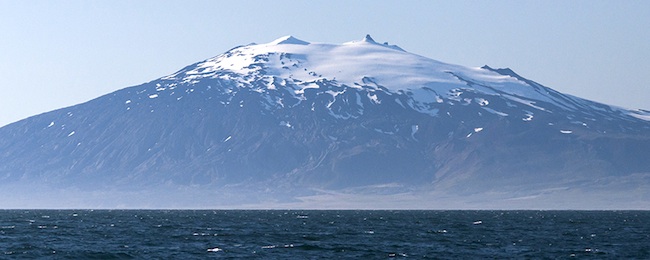Dispatch 1: It Begins
 The JCR in Reykjavik Harbor |
28th July 2012
It’s 1500 on Friday the 27th of July, a beautiful, cool, and cloudless afternoon in Reykjavik, Iceland. The ship’s crew and officers, the scientists, technicians and their specialized equipment—all are aboard now, and the James Clark Ross is ready for sea. The harbor pilot has joined the Captain and Second Mate on the bridge.
“Take in the spring lines,” Captain Chapman orders by radio, “And single up the stern line.” We’re backing dead slow as the last line comes aboard, and, clear of the wharf, the Captain eases her stern to starboard—tourists are waving goodbye from the wharf—then forward between the inner harbor jetties. “Secure the starboard anchor,” says the Captain.
“Starboard anchor secure,” comes the reply a few minutes later from the bow.
“Secure the port anchor.”
“Port anchor, aye.”
At eleven knots on a heading of 294 degrees, we pass the mid-channel buoy away to starboard. Now we feel the gentle open-water swell beneath our feet.
It’s not coincidental that some of the earliest and greatest stories, from The Odyssey onward, are sea stories. Voyages have structure, natural beginnings, middles and ends. So let this, that first sense of the ocean’s roll, signal the beginning of our voyage.
* * * * * *
We steamed all afternoon and evening in the glow of whaleback mountains on the Snaefellsnes Peninsula away to starboard, and before midnight in high-latitude sunlight we came abeam of the perfectly conical, dormant volcano, snow on its point and higher flanks, called Snaefellsjökull. Eric the Red and his band of colonists passed this way in the 10th century. For him, like us, this was the last sight of land until he fetched the east coast of Greenland. And now, at 0800 on the 28th of July we’re passing 66° North by 26° West, 33 nautical miles south of the Arctic Circle, in the Denmark Strait, that storied body of water separating Iceland from Greenland. Though later we’ll be working well to the north, fundamentally this cruise is about the Denmark Strait.

Snaefellsjoküll
We’ll of course talk much more in the next four weeks about ocean circulation generally and the vital role of the Denmark Strait specifically. But for now suffice it to say that if a quantity of water flows northward, then an equal quantity must flow south—the laws of physics so require, and that’s why we call it circulation. Every second of every day the Gulf Stream System transports almost unimaginable quantities of warm, salty water northward into the Iceland and Greenland seas from the tropical Atlantic. After circling the ocean basin north of Iceland, most of that water enters the Denmark Strait and proceeds southward at depth back toward the equator. It’s joined in the strait by cold, fresh water emanating from the High Arctic flowing southward along the east coast of Greenland. This is called, therefore, the East Greenland Current.
"The stability of our world’s climate depends quite literally on the integrity of the circulation in the waters on which floats the James Clark Ross at this very moment here in the middle of the Denmark Strait"
Here I’ve made an extremely complex oceanographic process sound simple and straightforward, but, then, the scientific work, like the cruise itself, has only just begun. Now, midafternoon, we’ve started to measure by various means the flow through the strait. In about ten days we’ll head north close aboard Greenland, the largest island in the world, to measure the East Greenland Current. In the days to come we’ll talk about how our onboard scientists measure an ocean, the specialized tools required to do so, including the ship, the people who operate her, and the technicians who actually put the instruments in the water and (in most instances) retrieve them. But for now, on the first full day, let’s begin to think in broad conceptual terms about ocean circulation, currents flowing north and returning southward in perpetual motion. It’s important. The stability of our world’s climate depends quite literally on the integrity of the circulation in the waters on which floats the James Clark Ross at this very moment here in the middle of the Denmark Strait with three million cubic meters of water flowing beneath her keel every second.
- Dallas
















